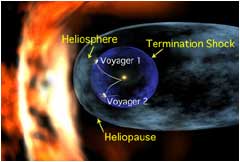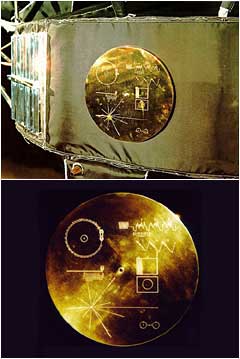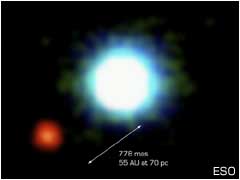 |
 |

An Illustrated image of the heliosphere. The dot in the center presents the Sun.(Courtesy of NASA)


The Golden Record attached to the Voyager spacecraft(Courtesy of NASA)


A planet in the outer solar system (the red object seen on the left-bottom)
 |
|
 |
 |
 |
 |
 |

Where are the two Voyagers located currently?
The Voyager spacecraft are headed out towards interstellar space. Today Voyager 1 is about 14 billion km from the sun and Voyager 2 is about 11 billion km from the sun. That's almost a hundred times as far from the sun as the Earth is. To give you a sense of scale, Neptune is 30 times as far from the sun as the Earth is.
Were you always expecting them to get this far and the mission to last this long?
We hoped, but of course when the two Voyager spacecraft were launched in 1977, the space age itself was just 20 years old. So there was no way to predict based on experience that any spacecraft could last as long as Voyager has already lasted. But we also knew that once you launch a spacecraft, then it's the consumables that ultimately will limit the spacecraft's lifespan. The key thing for space probes to be reliable is to have a lot of margin in the parts that you use and in the overall capability of the spacecraft, so that even as the spacecraft ages it still can function. We have enough electrical power, which comes from a nuclear battery, that if nothing breaks we believe we can continue to run the spacecraft until about the year 2020, when Voyager 1 will be almost 150 times as far from the sun as the Earth and could well be in interstellar space for the first time.
As the two spacecraft reach the outer edges of interstellar space, the wind from the sun is supersonic. It's blowing at about 1.5 million km/h. And so before it can run into the interstellar wind, it has to abruptly slow down, in a sonic shock. And Voyager 1 has now crossed that shock, which is called the termination shock.
What was the reason that the message to space aliens was installed on Voyager? Do you believe that space aliens would be able to play the messages on the Golden Disc?
Well, the Golden Disc is an old-fashioned analog record which has grooves on it, but it has on it images of Earth, languages from Earth, and sounds of Earth. And so it tries to encapsulate the Earth to some other intelligent being. We knew when we launched Voyager that these two would be our first probes to reach interstellar space. They're headed in the direction that will take them outside of our bubble the fastest. So we felt it was appropriate to send a message saying Earth finally has the technology to journey into interstellar space for the first time. In fact, the message is more important for us on Earth, because it's unlikely it will ever be found, but it's a very important message that we finally had the technology to be able to send a message deep into interstellar space, to leave the Earth forever.
We know that planets are fairly common in our galaxy and elsewhere in the universe. I think it's very likely that there is microbial life elsewhere in the universe. There may well be microbial life elsewhere in our own solar system. And we're trying to find any evidence that there was life at one time on Mars or perhaps still is; perhaps life on Europa in its ocean beneath its icy crust, but it is likely there is microbial life elsewhere in our own galaxy, the Milky Way.
What are some of the important things to consider when we proceed with space exploration in the future?
I like to think of the purpose of space exploration and space activity as expanding the five frontiers of space. Those frontiers are: the physical frontier - going somewhere that spacecraft have never been before; the knowledge frontier - understanding the science of what's out there; the technical frontier - developing the technology so we can operate in this new realm of human activity; the human frontier - understanding how humans can function in space; and finally the applications frontier - how do we develop the applications so that space can, in fact, improve life here on Earth? Those are the five frontiers, and I think each of the missions that all of the space agencies of the world launch should push one or more of those frontiers. Space is still the newest realm of human activity, less than 50 years old, and there's still a lot to be done, but we need to expand the five frontiers so that we can become even more of a space-faring world.
The most important thing about space exploration is to continue to learn, to do things where we're learning something new. You're learning something new by going somewhere you haven't been before, by seeing what's there and understanding it, by developing the technology that allows you to do things for the first time; learning something new about humans in space, about looking at Earth, and finding ways to use space observations to improve the quality of life on Earth. It's learning that is the key to the future of space as it is to much else.
|
 |
|

